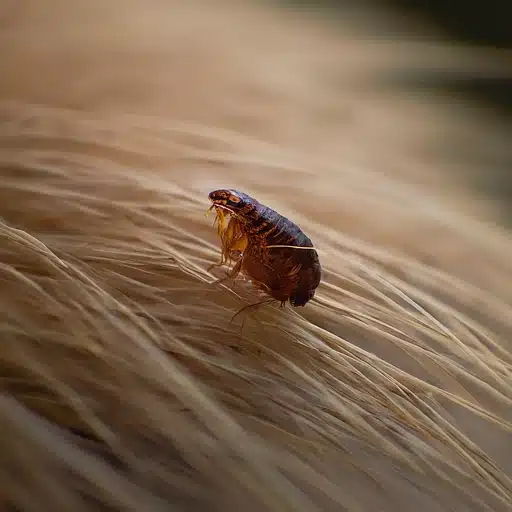Dogs are known as man’s best friend, and cats are not far behind them according to your Tulsa exterminator. Our pets are very important to us in modern society. They’re just as much a part of the family as any other member. Because of this, it’s important that we protect our loved ones, especially our pets, from pests that could possibly hurt them. The number one pest that our pets deal with are fleas. These small insects are blood feeders that parasite off of our dogs, cats and other pets. In this article, let’s take a good hard look at fleas, their lifecycle and what we can do to protect our pets and loved ones from fleas.
BLOOD FEEDING FLEAS AND TULSA EXTERMINATOR
Fleas are blood feeders. In America, your Tulsa exterminator fights the cat flee. Even though it’s named the cat flea, it doesn’t exclusively feed upon the blood of cats. It will feed on cats, dogs, rabbits, even us if they can get a hold of us. In Europe, they have the dog flea. Much like the cat flea, it will feed on pets or people. Because of this, it’s very important that we protect our animals from fleas. The first line of defense when it comes to doing this are deterrence that are prescribed by your veterinarian. These treatments can keep fleas off of your animal and eliminate an infestation that has already started. Veterinarians will often prescribe flea collars, dips, drops, pills, baths any other solutions to the flea issue. But getting the fleas off of your pet is only the first step in dealing with these insects.
Fleas not only infest the fur and skin of our pets, but they also can find their way into our homes. To understand this, it is important that you understand the lifecycle of a flea. Fleas develop using a complete metamorphosis. This means that they start as an egg, and hatch into a larva. After this larva stage, they will pupate or cocoon themselves and then finally emerge as an adult. When dealing with fleas in your home, it’s important to understand that pesticides can only eliminate fleas when they’re in their larva stage or their adult stage. When they’re in the egg or the cocoon, they’re protected from these outside factors and can’t be eliminated.
FLEA LIFECYCLE AND TULSA EXTERMINATOR
An adult flea will lay eggs at the base of the fur of the animal that they are feeding on. As the animal scratches, it will break loose these eggs and they will fall to the ground. This usually happens in the carpeted area somewhere around where the animal sleeps or has high traction. It’s here that these eggs will hatch. The larva will emerge and make its way through the carpet and the bedding of the animal. The adult fleas on the host will defecate, leaving what’s known as flea dust. These droppings will fall off the animal usually through scratching or some other method, and then find a way to the ground below. Here the flea larva will consume the droppings in an effort to get any undigested blood.
As a flea has developed as far as it can as a larva, it will find dust, dirt, hair, fur or anything else that it can find to create its cocoon. Once inside, it will develop until it reaches adulthood. As it senses a possible host nearby, it will emerge from the cocoon. Eggs also are able to sense hosts nearby and use that to know when to come out of their egg. This gives these insects the ability to overwinter clinging onto the host as an adult during the winter months. When in egg or pupa form, they can sense the heat and vibration of an animal nearby. You can simulate this by vacuuming your house often in order to get these insects out of their egg and cocoon, and in contact with the treatment administered by your Tulsa exterminator.
TRAVELING FLEAS AND TULSA EXTERMINATOR
Once the insect emerges as an adult, it has the ability to jump very long distances. This is given to it by it’s very strong legs. These legs have a gearing mechanism built into them where they are hinged together so that they are synchronized perfectly. Due to the force that’s required to throw the flea as far as it needs to, synchronization is very important. It would be impossible to aim for a host if both legs are not giving up the exact same amount of power. There’s a muscle in the center of the adult flea that flexes like a coiled up spring holding energy. And then all at once the spring explodes, forcing the legs down and shooting the flea sometimes 40 or 50 times its own height. This gives the flea the ability to make the leap between ground and host effectively.
Fleas also have unique sets of legs that are jointed backwards so that they can wrap their legs around the base of fur. This gives them the ability to maneuver through an animals fur and cling tightly when the animal is scratching. Adult fleas will mate on the skin and then the female will lay eggs. Once this happens the cycle repeat itself over again. In addition to treating the inside of your home with a Tulsa exterminator, you may need to treat the outside of your home. Some yards have massive flea infestation‘s, and taking care of those fleas can limit the number of insects that can get on your animal and into your house.
YOUR TULSA EXTERMINATOR TO THE RESCUE
If you’re having an issue of fleas or any other insects it’s time to give your Tulsa exterminator a call. Here at TermMax Pest Control, we are the best of the business when it comes to dealing with fleas or any other insect issues. We service the greater Tulsa area including Coweta, Claremore, Broken Arrow, Sand Springs, Turley, Owasso, Catoosa, Bixby, Jenks, Prattville, Sapulpa and much more. Call today for a free estimate. We’re here to help!



